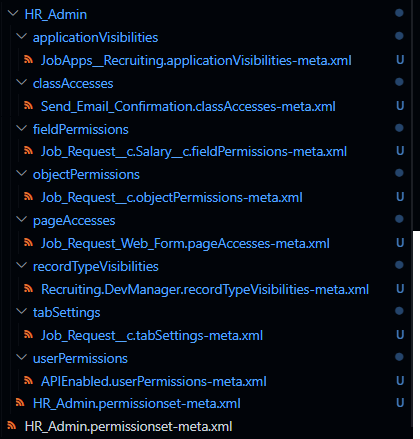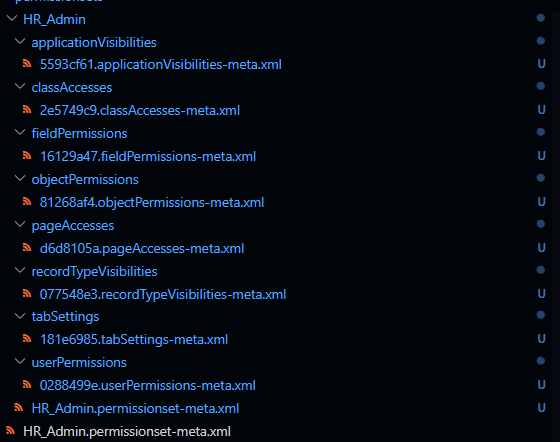A JavaScript package to disassemble XML files into smaller, more manageable files and re-assemble them when needed.
Table of Contents
Large XML files, especially those generated by external tools, can be challenging to review and manage. These files contains thousands of lines of elements, making it difficult to track changes during version control and easy to lose changes if these files are automatically generated. Traditional diff algorithms are not always suitable for these types of files, and manually reviewing changes can be time-consuming and error-prone.
The XML Disassembler package addresses this issue by breaking down large XML files into smaller, more digestible chunks. This makes it easier to review changes, identify additions and deletions, and collaborate on version control repositories in GitHub, GitLab, etc. that store XML files.
Using a custom XML diff algorithm can be beneficial in some cases. However, these algorithms are often complex and require significant expertise to implement correctly. Additionally, they may not be compatible with all types of XML files or your version control instance and could introduce errors during the diffing process.
The XML Disassembler package offers a simpler alternative by breaking down XML files into smaller parts. This approach is more straightforward and easier to understand, making it suitable for a wider range of users. It also allows for more granular control over the review process, as each individual file can be reviewed separately.
While there are trade-offs between using a custom diff algorithm and the XML Disassembler package, the latter provides a practical and accessible solution for managing large XML files.
Install the package using NPM:
npm install xml-disassembler
Disassemble 1 XML file or multiple XML files in the immediate directory, without recursion. Each XML file will be disassembled into their own sub-directories using their base name (everything before the first . in the file-name). The paths you provide must be relative paths.
Example:
An XML file (HR_Admin.permissionset-meta.xml) with the following nested and leaf elements
<?xml version="1.0" encoding="UTF-8"?>
<PermissionSet xmlns="http://soap.sforce.com/2006/04/metadata">
<applicationVisibilities>
<application>JobApps__Recruiting</application>
<visible>true</visible>
</applicationVisibilities>
<classAccesses>
<apexClass>Send_Email_Confirmation</apexClass>
<enabled>true</enabled>
</classAccesses>
<fieldPermissions>
<editable>true</editable>
<field>Job_Request__c.Salary__c</field>
<readable>true</readable>
</fieldPermissions>
<description>Grants all rights needed for an HR administrator to manage employees.</description>
<label>HR Administration</label>
<userLicense>Salesforce</userLicense>
<objectPermissions>
<allowCreate>true</allowCreate>
<allowDelete>true</allowDelete>
<allowEdit>true</allowEdit>
<allowRead>true</allowRead>
<viewAllRecords>true</viewAllRecords>
<modifyAllRecords>true</modifyAllRecords>
<object>Job_Request__c</object>
</objectPermissions>
<pageAccesses>
<apexPage>Job_Request_Web_Form</apexPage>
<enabled>true</enabled>
</pageAccesses>
<recordTypeVisibilities>
<recordType>Recruiting.DevManager</recordType>
<visible>true</visible>
</recordTypeVisibilities>
<tabSettings>
<tab>Job_Request__c</tab>
<visibility>Available</visibility>
</tabSettings>
<userPermissions>
<enabled>true</enabled>
<name>APIEnabled</name>
</userPermissions>
</PermissionSet>will be disassembled into a sub-directory named HR_Admin as such:
- Each nested element (
<recordTypeVisibilities>,<applicationVisibilities>,pageAccesses, etc.) will be disassembled into further sub-directories by the nested element name. If a unique & required ID element (applicationis the unique ID element for<applicationVisibilities>) is found, the disassembled file will be named using it. Otherwise, the disassembled files for nested elements will be named using the SHA-256 of the element contents. - Each leaf element (
<description>,<label>,<userLicense>) will be disassembled into the same file in the first sub-directory, which will have the same file-name as the original file.
Import the DisassembleXMLFileHandler class from the package.
/*
FLAGS
- filePath: Relative path to 1 XML file or a directory of XML files to disassemble. If the path provided is a directory, only the files in the immediate directory will be disassembled.
- uniqueIdElements: (Optional) Comma-separated list of unique and required ID elements used to name disassembled files for nested elements.
Defaults to SHA-256 hash if unique ID elements are undefined or not found.
- prePurge: (Optional) Boolean value. If set to true, purge pre-existing disassembled directories prior to disassembling the file.
Defaults to false.
- postPurge: (Optional) Boolean value. If set to true, purge the original XML file after disassembling it.
Defaults to false.
- ignorePath: (Optional) Path to an ignore file containing XML files to ignore during disassembly. See "Ignore File" section.
*/
import { DisassembleXMLFileHandler } from "xml-disassembler";
const handler = new DisassembleXMLFileHandler();
await handler.disassemble({
filePath: "test/baselines/general",
uniqueIdElements:
"application,apexClass,name,externalDataSource,flow,object,apexPage,recordType,tab,field",
prePurge: true,
postPurge: true,
ignorePath: ".xmldisassemblerignore",
});Reassemble 1 XML directory (filePath) containing disassembled files back into 1 XML file. The paths you provide must be relative paths.
NOTE: You should be reassembling files created by this package's DisassembleXMLFileHandler class for intended results. This class will assume all disassembled files in filePath have the same XML Root Element. The reassembled XML file will be created in the parent directory of filePath and will overwrite the original file used to create the original disassembled directories, if it still exists and the fileExtension flag matches the original file extension.
Import the ReassembleXMLFileHandler class from the package.
/*
FLAGS
- filePath: Relative path to the disassembled XML files to reassemble (must be a directory)
- fileExtension: (Optional) Desired file extension for the final XML (default: `.xml`)
- postPurge: (Optional) Boolean value. If set to true, purge the disassembled file directory (filePath) after reassembly.
Defaults to false.
*/
import { ReassembleXMLFileHandler } from "xml-disassembler";
const handler = new ReassembleXMLFileHandler();
await handler.reassemble({
filePath: "test/baselines/general/HR_Admin",
fileExtension: "permissionset-meta.xml",
postPurge: true,
});Refer to the Salesforce plugin, SFDX Decomposer, to see a use case of this package:
If you wish, you can create an ignore file to have the disassembler ignore specific XMLs similar to a .gitignore file.
The disassembler uses the node-ignore package to parse ignore files that follow .gitignore spec 2.22.1.
By default, the XML disassembler will look for an ignore file named .xmldisassemblerignore in the current working directory. Set the ignorePath flag to override this ignore path.
The XML parser, which uses the fast-xml-parser package, is configured to retain any Character Data (CDATA) values (<![CDATA[some stuff]]>) and comments (<translation><!-- Four --></translation>) in the original XML file.
By default, the package will not print any debugging statements to the console. Any error or debugging statements will be added to a log file, disassemble.log, created in the same directory you are running this package in. This file will be created when running the package in all cases, even if there are no errors.
The logger's default state is to only log errors to disassemble.log. Check this file for ERROR statements that will look like:
[2024-03-30T14:28:37.950] [ERROR] default - The XML file HR_Admin.no-nested-elements.xml only has leaf elements. This file will not be disassembled.
To add additional debugging statements to the log file, import the setLogLevel function from the package and run the function with debug to print all debugging statements to a log file.
When the log level is set to debug, the log file will contain statements like this to indicate which files were processed for disassembly and reassembly:
[2024-03-30T14:28:37.926] [DEBUG] default - Parsing directory to reassemble: mock/no-namespace/HR_Admin
[2024-03-30T14:28:37.936] [DEBUG] default - Created reassembled file: mock\no-namespace\HR_Admin.permissionset-meta.xml
[2024-03-30T14:28:37.951] [DEBUG] default - Parsing file to disassemble: mock\no-nested-elements\HR_Admin.permissionset-meta.xml
[2024-03-30T14:28:37.953] [DEBUG] default - Created disassembled file: mock\no-nested-elements\HR_Admin\applicationVisibilities\5593cf61.applicationVisibilities-meta.xml
[2024-03-30T14:28:37.954] [DEBUG] default - Created disassembled file: mock\no-nested-elements\HR_Admin\classAccesses\2e5749c9.classAccesses-meta.xml
[2024-03-30T14:28:37.955] [DEBUG] default - Created disassembled file: mock\no-nested-elements\HR_Admin\fieldPermissions\16129a47.fieldPermissions-meta.xml
[2024-03-30T14:28:37.956] [DEBUG] default - Created disassembled file: mock\no-nested-elements\HR_Admin\objectPermissions\81268af4.objectPermissions-meta.xml
[2024-03-30T14:28:37.956] [DEBUG] default - Created disassembled file: mock\no-nested-elements\HR_Admin\pageAccesses\d6d8105a.pageAccesses-meta.xml
[2024-03-30T14:28:37.957] [DEBUG] default - Created disassembled file: mock\no-nested-elements\HR_Admin\recordTypeVisibilities\077548e3.recordTypeVisibilities-meta.xml
[2024-03-30T14:28:37.957] [DEBUG] default - Created disassembled file: mock\no-nested-elements\HR_Admin\tabSettings\181e6985.tabSettings-meta.xml
[2024-03-30T14:28:37.958] [DEBUG] default - Created disassembled file: mock\no-nested-elements\HR_Admin\userPermissions\0288499e.userPermissions-meta.xml
[2024-03-30T14:28:37.959] [DEBUG] default - Created disassembled file: mock\no-nested-elements\HR_Admin\HR_Admin.permissionset-meta.xml
import {
DisassembleXMLFileHandler,
ReassembleXMLFileHandler,
setLogLevel,
} from "xml-disassembler";
const debug: boolean = true;
if (debug) {
setLogLevel("debug");
}
const disassembleHandler = new DisassembleXMLFileHandler();
await disassembleHandler.disassemble({
filePath: "test/baselines/general",
uniqueIdElements:
"application,apexClass,name,externalDataSource,flow,object,apexPage,recordType,tab,field",
prePurge: true,
postPurge: true,
});
const reassembleHandler = new ReassembleXMLFileHandler();
await reassembleHandler.reassemble({
filePath: "test/baselines/general/HR_Admin",
fileExtension: "permissionset-meta.xml",
});These 2 extension packages depend on XML disassembler:
- XML2JSON Disassembler: Disassemble large XML files into smaller JSON files and reassemble the original XML file when needed
- XML2YAML Disassembler: Disassemble large XML files into smaller YAML files and reassemble the original XML file when needed
This project was created from a template provided by Allan Oricil. Thank you Allan!
His original license remains in this project.



